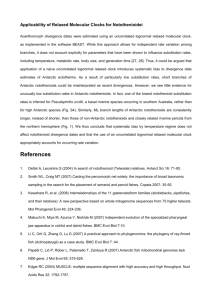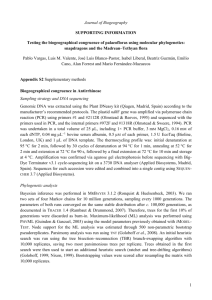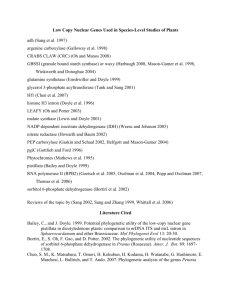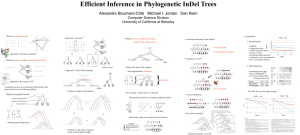ele12183-sup-0001-Methods
advertisement
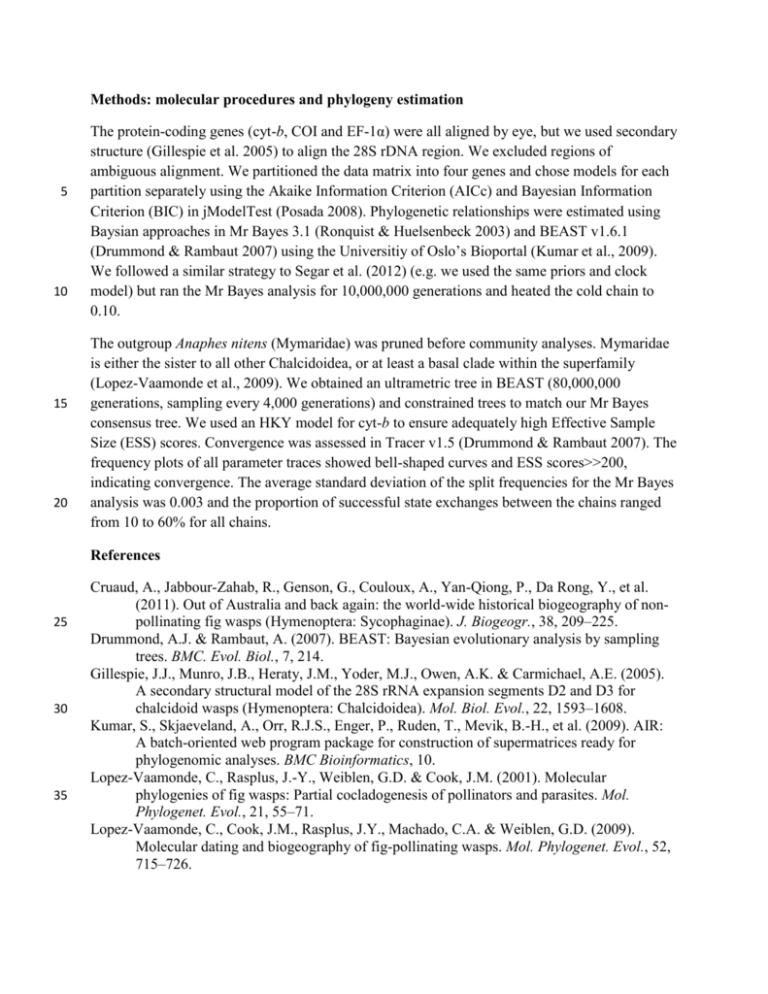
Methods: molecular procedures and phylogeny estimation 5 10 15 20 The protein-coding genes (cyt-b, COI and EF-1α) were all aligned by eye, but we used secondary structure (Gillespie et al. 2005) to align the 28S rDNA region. We excluded regions of ambiguous alignment. We partitioned the data matrix into four genes and chose models for each partition separately using the Akaike Information Criterion (AICc) and Bayesian Information Criterion (BIC) in jModelTest (Posada 2008). Phylogenetic relationships were estimated using Baysian approaches in Mr Bayes 3.1 (Ronquist & Huelsenbeck 2003) and BEAST v1.6.1 (Drummond & Rambaut 2007) using the Universitiy of Oslo’s Bioportal (Kumar et al., 2009). We followed a similar strategy to Segar et al. (2012) (e.g. we used the same priors and clock model) but ran the Mr Bayes analysis for 10,000,000 generations and heated the cold chain to 0.10. The outgroup Anaphes nitens (Mymaridae) was pruned before community analyses. Mymaridae is either the sister to all other Chalcidoidea, or at least a basal clade within the superfamily (Lopez-Vaamonde et al., 2009). We obtained an ultrametric tree in BEAST (80,000,000 generations, sampling every 4,000 generations) and constrained trees to match our Mr Bayes consensus tree. We used an HKY model for cyt-b to ensure adequately high Effective Sample Size (ESS) scores. Convergence was assessed in Tracer v1.5 (Drummond & Rambaut 2007). The frequency plots of all parameter traces showed bell-shaped curves and ESS scores>>200, indicating convergence. The average standard deviation of the split frequencies for the Mr Bayes analysis was 0.003 and the proportion of successful state exchanges between the chains ranged from 10 to 60% for all chains. References 25 30 35 Cruaud, A., Jabbour-Zahab, R., Genson, G., Couloux, A., Yan-Qiong, P., Da Rong, Y., et al. (2011). Out of Australia and back again: the world-wide historical biogeography of nonpollinating fig wasps (Hymenoptera: Sycophaginae). J. Biogeogr., 38, 209–225. Drummond, A.J. & Rambaut, A. (2007). BEAST: Bayesian evolutionary analysis by sampling trees. BMC. Evol. Biol., 7, 214. Gillespie, J.J., Munro, J.B., Heraty, J.M., Yoder, M.J., Owen, A.K. & Carmichael, A.E. (2005). A secondary structural model of the 28S rRNA expansion segments D2 and D3 for chalcidoid wasps (Hymenoptera: Chalcidoidea). Mol. Biol. Evol., 22, 1593–1608. Kumar, S., Skjaeveland, A., Orr, R.J.S., Enger, P., Ruden, T., Mevik, B.-H., et al. (2009). AIR: A batch-oriented web program package for construction of supermatrices ready for phylogenomic analyses. BMC Bioinformatics, 10. Lopez-Vaamonde, C., Rasplus, J.-Y., Weiblen, G.D. & Cook, J.M. (2001). Molecular phylogenies of fig wasps: Partial cocladogenesis of pollinators and parasites. Mol. Phylogenet. Evol., 21, 55–71. Lopez-Vaamonde, C., Cook, J.M., Rasplus, J.Y., Machado, C.A. & Weiblen, G.D. (2009). Molecular dating and biogeography of fig-pollinating wasps. Mol. Phylogenet. Evol., 52, 715–726. 40 45 50 Machado, C.A., Jousselin, E., Kjellberg, F., Compton, S.G. & Herre, E.A. (2001). Phylogenetic relationships, historical biogeography and character evolution of fig-pollinating wasps. Roy. Soc. Lond. B. Bio. P., 268, 685–694. Marussich, W.A. & Machado, C.A. (2007). Host-specificty and coevolution among pollinating and non-pollinating New World fig wasps. Mol. Ecol., 16, 1925–1946. McLeish, M.J., Van Noort, S. & Tolley, K.A. (2010). Parasitoid fig-wasp evolutionary diversification and variation in ecological opportunity. Mol. Ecol., 19, 1483–1496. Posada, D. (2008). jModelTest: phylogenetic model averaging. Mol. Biol. Evol., 25, 1253–1256. Ronquist, F. & Huelsenbeck, J.P. (2003). MRBAYES 3: Bayesian phylogenetic inference under mixed models. Bioinformatics, 1572–1574.
